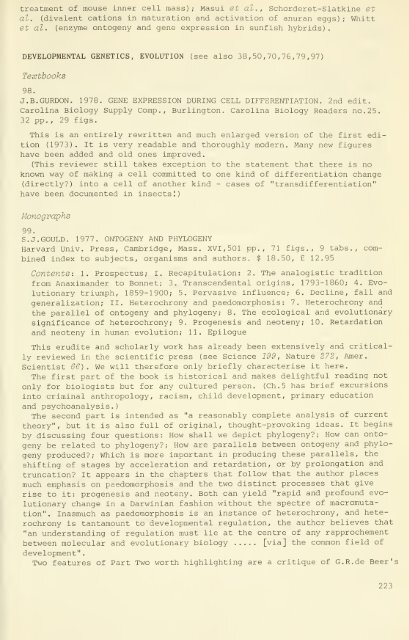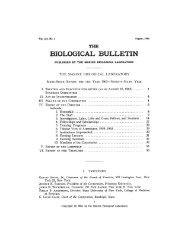General embryological information service - HPS Repository
General embryological information service - HPS Repository
General embryological information service - HPS Repository
You also want an ePaper? Increase the reach of your titles
YUMPU automatically turns print PDFs into web optimized ePapers that Google loves.
treatment of mouse inner cell mass); Masui et a1., Schorderet-Slatkine et<br />
at. (divalent cations in maturation and activation of anuran eggs) ; Whitt<br />
et at. (enzyme ontogeny and gene expression in sunfish hybrids)<br />
DEVELOPMENTAL GENETICS, EVOLUTION (see also 38,50,70,76,79,97)<br />
Textbooks<br />
98.<br />
J.B.GURDON, 1978. GENE EXPRESSION DURING CELL DIFFERENTIATION. 2nd edit.<br />
Carolina Biology Supply Comp., Burlington. Carolina Biology Readers no. 25.<br />
32 pp. , 29 figs.<br />
This is an entirely rewritten and much enlarged version of the first edition<br />
(1973). It is very readable and thoroughly modern. Many new figures<br />
have been added and old ones improved.<br />
(This reviewer still takes exception to the statement that there is no<br />
known way of making a cell committed to one kind of differentiation change<br />
(directly?) into a cell of another kind - cases of "transdif ferentiation"<br />
have been documented in insects 1)<br />
Monographs<br />
.<br />
99.<br />
S.J.GOULD. 1977. ONTOGENY AND PHYLOGENY<br />
Harvard Univ. Press, Cambridge, Mass, XVI, 501 pp., 71 figs., 9 tabs., combined<br />
index to subjects, organisms and authors. $ 18.50, £ 12.95<br />
Contents: 1. Prospectus; I. Recapitulation: 2. The analogistic tradition<br />
from Anaximander to Bonnet; 3, Transcendental origins, 1793-1850; 4. Evolutionary<br />
triumph, 1859-1900; 5. Pervasive influence; 6. Decline, fall and<br />
generalization; II. Heterochrony and paedomorphosis: 7. Heterochrony and<br />
the parallel of ontogeny and phylogeny; 8. The ecological and evolutionary<br />
significance of heterochrony; 9. Progenesis and neoteny; 10. Retardation<br />
and neoteny in human evolution; 11. Epilogue<br />
This erudite and scholarly work has already been extensively and critically<br />
reviewed in the scientific press (see Science 199, Nature 272, Amer.<br />
Scientist 66). We will therefore only briefly characterise it here.<br />
The first part of the book is historical and makes delightful reading not<br />
only for biologists but for any cultured person. (Ch.5 has brief excursions<br />
into criminal anthropology, racism, child development, primary education<br />
and psychoanalysis.)<br />
The second part is intended as "a reasonably complete analysis of current<br />
theory", but it is also full of original, thought-provoking ideas. It begins<br />
by discussing four questions: How shall we depict phylogeny?; How can ontogeny<br />
be related to phylogeny?; How are parallels between ontogeny and phylogeny<br />
produced?; Which is more important in producing these parallels, the<br />
shifting of stages by acceleration and retardation, or by prolongation and<br />
truncation? It appears in the chapters that follow that the author places<br />
much emphasis on paedomorphosis and the two distinct processes that give<br />
rise to it: progenesis and neoteny. Both can yield "rapid and profound evolutionary<br />
change in a Darwinian fashion without the spectre of macromutation".<br />
Inasmuch as paedomorphosis is an instance of heterochrony, and heterochrony<br />
is tantamount to developmental regulation, the author believes that<br />
"an understanding of regulation must lie at the centre of any rapprochement<br />
between molecular and<br />
development"<br />
evolutionary biology [via] the common field of<br />
Two features of Part Two worth highlighting are a critique of G.R.de Beer's<br />
.<br />
223
















